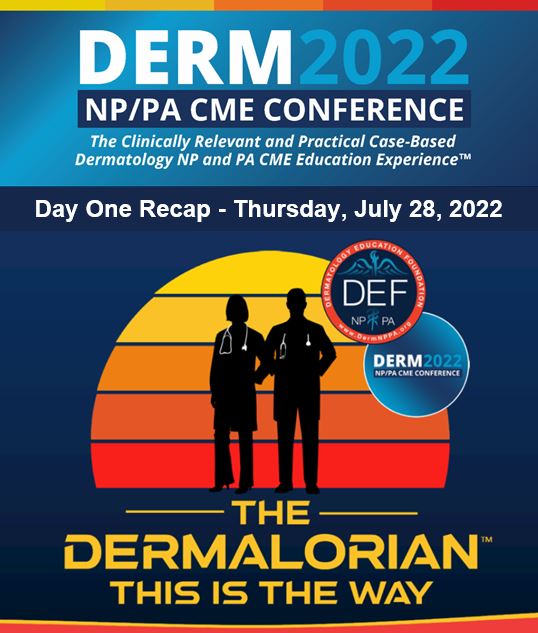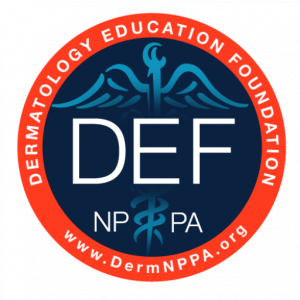

Highlights from Today’s CME Presentations:
Tips for Providing Better Atopic Dermatitis (AD) Care with Adam Friedman
Dr. Adam Friedman started strong this morning with what he described as “Easy Opportunities to Improve AD Care!” We must utilize our educational resources, set realistic expectations, encourage follow up, and give each patient adequate amounts medication. Given the profound impact of this diagnosis on Americans, we do well to recognize the most common phenotypes of this chronic, inflammatory disorder. Dr. Friedman reminded us that the term, “eczema” is an umbrella term encompassing many different presentations on the hands, trunk, extremities.
He encouraged us to begin with the basics of skin hygiene for optimal outcomes. We can’t assume our patients and their caregivers understand skin hygiene. When it comes to soaps, we don’t like them! Choose a gentle, non-soap cleanser and pH is vastly important! The lower the pH, the better for reduction of superinfection. He reminded us there are inherent risks in undertreatment of AD. Oh, how we love pictures in dermatology! Dr. Friedman shared some crippling images of cutaneous bacterial and viral infections in AD patients and even described best practices for confirmation of diagnosis and treatment. He advised us not to ignore co-morbidities in AD including cardiometabolic risks, mental health, infection, and sleep disturbances. He gave us a simple algorithm for what to do when “NOTHING WORKS!” We should ask our patients which topicals, how strong, how long, and how much. When our patients are a mess, he recommended we “Go Strong or Go Home!” Obviously, with aggressive treatment we should consider prompt follow up.
Other words of wisdom from Dr. Friedman included tools to ensure we are not being a “Grinch” with topicals, a simple way to calculate how many grams to order based upon age and BSA, and an incredibly useful “fingertip unit” tool as an application strategy. Consider confirmation of diagnosis when patients don’t respond as expected. There are many systemic agents in our AD treatment armamentarium including some “New Kids on the Block”—the systemic and topical janus kinase inhibitors. Finally, Dr. Friedman ended his talk with a reminder to utilize our resources including the National Eczema Foundation, peers, and best-practice treatment guidelines for optimal outcomes.
Translating Psoriasis Guidelines into Practice with April Armstrong
Dr. April Armstrong shared useful wisdom for applying psoriasis treatment guidelines into practice in her talk entitled, “Translating Psoriasis Guidelines into Practice.” Dr. Armstrong reminded us that before we decide on a treatment option, we must classify our patients with psoriasis by whether they are candidates for topical or systemic therapy. She recommended using not only BSA measurements but also “special areas” such as face, hands, etc. as well as topical treatment failures for this consideration. According to Dr. Armstrong, the following special populations dictate currently FDA-approved therapies in psoriasis (PSO) biologic agent selection: Psoriatic Arthritis (PSA), cardiovascular co-morbidities, any history of malignancy, and active tuberculosis.
For best outcomes, she recommended having a proactive approach to topical therapies. Consider baseline use of topical therapies twice weekly for maintenance. Consider optimizing steroidal and non-steroidal therapies to give patients clearer skin. Dr. Armstrong shared when and where she uses methotrexate, cyclosporine, acitretin, apremilast, as well as approved biologic therapies as well as management strategies. She gave us some strategies for dose escalation with patients who have lost efficacy and even shared the evidence for our review. She gave us some tangible advice for the consideration of switching therapy vs. dose escalation in biologics including primarily vs. secondary treatment failures, in-class switching, and ended with a reminder to always treat the whole patient—co-morbidities and all.
Psoriasis Therapeutic Update 2022: The Future Just Keeps Getting Brighter with Brad Glick
Dr. Brad Glick began his talk with an overview of treatment therapies used for psoriasis from the 1800’s to present-day. He outlined scientific understanding of psoriasis including cause and treatment targets from pre-1980 to current day as well. He briefly discussed clinical treatment targets including a 1% or less BSA by 3 months, PGA of clear or almost clear, PASI 90 and PASI 100 responses, and PASI 90 with a PGA of 0-1. My how we’ve come a long way!
The National Psoriasis Foundation has encouraged us to evaluate psoriasis response to new therapies at 3 months. They want us to aim high with our evaluation which should include BSA of less than or equal to 3% with a target response every 6 months of BSA less than or equal to 1%. Dr. Glick briefly discussed therapies, both past and present, for the treatment of psoriatic disease and even discussed some investigational treatment targets to come! We looked at comparative PASI responses for currently utilized therapies as well.
Dr. Glick recommended considering all psoriasis treatments as “tools” in a “toolbox.” One therapy may be appropriate for one patient and not another for many reasons. He gave us some helpful tips for choosing which treatment option is best and, utilizing statistical analysis with placebo as the active comparator, showed us some interesting data about which agent performed the best (ixekizumab and risankizumab lead the group for outcome responses)! He reminded us to begin to understand expectations for biosimilars of biologic agents recognizing they are not the same. He also briefly discussed the psoriasis treatment pipeline for our consideration. The pipeline is strong for topical therapies including taparinof and roflumilast. In addition, all eyes are on a small molecule deucravacitinib and the FDA. Will this therapy end up with a dreaded black box? He ended his discussion with a brief overview of bimekizumab, an investigational IL-17A and IL-17F biologic therapy. The future looks bright, friends!
Are You What You Eat? Diet and Psoriasis with April Armstrong
How many times have you been asked in clinic about diet and psoriasis? Well, thanks to Dr. April Armstrong, now we have some data to share! She began her talk to 3 questions: Are gluten-free diets helpful in psoriasis, what is the effect of dietary weight reduction in psoriasis, and are there any specific foods or nutrients or dietary patterns helpful in psoriasis? Are you baited yet?
There are several serum antibody tests used to screen patients with psoriasis for gluten sensitivity and allergy. Patients with high suspicion of Celiac Disease should have a small intestinal biopsy. Did you know celiac Disease is twice as common in psoriasis patients when compared with the general population?
The National Psoriasis Foundation gave us some dietary recommendations for adults with psoriatic disease. In patients with confirmed Celiac Disease, a gluten-free diet should be standard and will reduce GI symptoms and psoriasis severity. In patients who test positive for markers of gluten sensitivity, a gluten-free diet can lead to improvement in psoriasis severity. However, in patients who test negative for gluten sensitivity, there is no benefit from a gluten-free diet. Further, Dr. Armstrong shared results from a 2019 study published in Nurses’ Health. The study analyzed 85,185 adult women and found no association between gluten intake and new-onset psoriasis or atopic dermatitis.
She concluded her discussion with obesity and psoriasis. Obesity is associated with increased risk of psoriasis, higher severity and reduced response to therapy. In patients who are overweight or obese, a low-calorie diet consisting of 800-1400 calories/day can lead to improvements in psoriatic disease severity, quality of life, and weight loss. While this is exciting and encouraging, Dr. Armstrong shared details indicating a diet alone may not be sufficient to maintain psoriasis remission for these patients. Studies evaluating Omega-3 Fatty Acids including fish oil supplementation in psoriasis patients show conflicting results. Oral supplementation was not beneficial. However, intravenous fish oil supplementation was beneficial for reducing psoriasis severity in 2 double-blinded randomized control trials. In addition, fish oil supplementation may have analgesic effects in patients with psoriatic arthritis. Dr. Armstrong shared low-quality evidence for Mediterranean diet, fiber, or complex carbohydrates in patients with psoriasis. And just to leave us all writhing, there is evidence that a Western Diet induces psoriatic disease activity in mice. In a study published in the Journal of Proteome Research in 2021, a very-low-calorie-ketogenic diet yielded a decrease in inflammatory markers for psoriatic disease, significant reduction of PASI and DLQI, and a decrease in glucose, total cholesterol, and LDL. For this reason, this is an area ripe for research!
Scientific Poster of the Day
POSTER NUMBER: 49
TITLE: Bimekizumab early treatment response translates into cumulative benefits in health-related quality of life in patients with moderate to severe plaque psoriasis: Pooled results from three multicenter, randomized, double-blinded phase 3 trials
AUTHORS & AFFILIATIONS:
Kenneth B. Gordon,1 Michael Sebastian,2 Steven R. Feldman,3 Paolo Eusebi,4 Krista Wixted,5 Cynthia Madden,5 Natalie Nunez Gomez,4 Valerie Ciaravino,6 Marc Radtke7
1Department of Dermatology, Medical College of Wisconsin, Milwaukee, WI, USA; 2Department of Dermatology, Dermatological Practice Mahlow, Mahlow, Germany; 3Department of Dermatology, Wake Forest School of Medicine, Winston-Salem, NC, USA; 4UCB Pharma, Brussels, Belgium; 5UCB Pharma, Raleigh, NC, USA; 6UCB Pharma, Colombes, France; 7Dermatologikum Hamburg GmbH, Dermatological Practice, Hamburg, Germany
ABSTRACT:
Introduction: Speed of clinical response is an important treatment goal for patients with plaque psoriasis.1 We examined how early clinical response translated into cumulative health-related quality of life (HRQoL) benefits in patients with moderate to severe plaque psoriasis treated with bimekizumab (BKZ) over 1 year.
Methods: Data were pooled for patients randomized to BKZ 320 mg every 4 weeks (Q4W) in BE SURE, BE READY, and BE RADIANT.2-4 Through Weeks 16–48, data were combined for both BKZ maintenance doses (BKZ 320 mg Q4W or Q8W). The proportions of patients achieving DLQI 0/1 (no effect of skin disease on patient’s life) are reported at Week 4 by PASI 90 status; cumulative HRQoL benefits through 48 weeks were estimated using total area under the curve (AUC0–48) for patients achieving DLQI 0/1 by Week 4 PASI 90 status. Missing data were imputed as non-response (NRI).
Results: At Week 4, 352/880 (40.0%) patients achieved PASI 90. 57.4% of Week 4 PASI 90 responders achieved DLQI 0/1, compared with 40.5% of Week 4 PASI 90 non-responders.
Total AUC0–48 for achievement of DLQI 0/1 was greater in Week 4 PASI 90 responders vs Week 4 PASI 90 non-responders: 3,664 vs 3,263. Patients who achieved PASI 90 at Week 4 achieved DLQI 0/1 for a greater number of days throughout the 48-week trial compared with patients who did not achieve PASI 90 at Week 4: 256 vs 228 days.
Conclusions: BKZ demonstrated fast skin clearance. Early treatment response on BKZ translated into cumulative benefits in HRQoL: Week 4 PASI 90 responders achieved DLQI 0/1 for a greater number of days during the 48-week trial than Week 4 PASI 90 non-responders.
SPONSOR: UCB, Inc.
